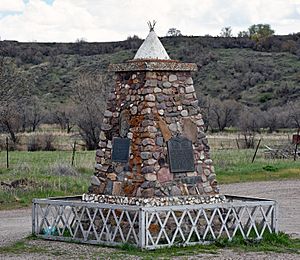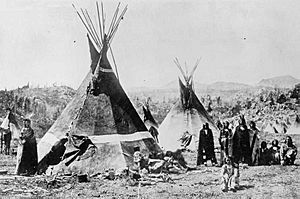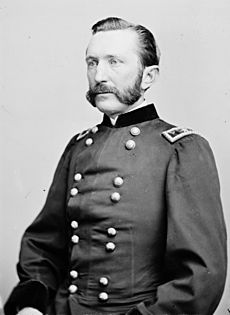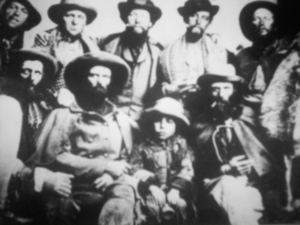Bear River Massacre facts for kids
Quick facts for kids Bear River Massacre |
|||||||
|---|---|---|---|---|---|---|---|
| Part of the American Indian Wars | |||||||
 A monument erected by the Daughters of Utah Pioneers commemorating the event. |
|||||||
|
|||||||
| Belligerents | |||||||
| Shoshone | |||||||
| Commanders and leaders | |||||||
| Bear Hunter † | |||||||
| Strength | |||||||
| ~200 | ~300 +families | ||||||
| Casualties and losses | |||||||
| 21 killed 46 wounded |
~250 killed ~160 wounded or captured |
||||||
The Bear River Massacre was a terrible event that happened on January 29, 1863, in what is now Franklin County, Idaho. For years, there had been small fights and raids for food between settlers and the Shoshone people. The United States Army attacked a Shoshone camp located where the Bear River and Battle Creek meet. This area was then part of the Washington Territory. Colonel Patrick Edward Connor led the soldiers against the Shoshone chief, Bear Hunter. Many Shoshone people were killed in this attack.
Contents
Why did the Bear River Massacre happen?

Cache Valley was a traditional hunting ground for the Northwestern Shoshone people. They gathered seeds, fished for trout, and hunted animals like buffalo, deer, and elk there. Fur trappers also visited this valley and used it to store their furs. This is why it was called "Cache Valley."
Settlers arrive and food becomes scarce
In 1847, Salt Lake City was founded, and the California Trail and Oregon Trail opened. This brought many white settlers moving west, which meant more contact with the Shoshone. By 1856, settlers began building farms in Cache Valley.
The leader of the Mormon settlers, Brigham Young, wanted his people to be friendly with Native American tribes. He encouraged them to "feed them rather than fight them." However, the settlers used a lot of the valley's resources. This pushed the Shoshone into areas where it was harder to find food.
In 1856, a government surveyor reported that the Shoshone complained. They said the Mormons used so much of Cache Valley that the animals they hunted were disappearing. Travelers on the trails also took food resources. By 1859, officials knew that the Shoshone were becoming poor because of the white population. They suggested creating a special area for the Shoshone in Cache Valley to protect their food. But this idea was not approved.
Because they were starving, the Shoshone sometimes attacked farms and ranches for food. For them, it was a matter of survival. In 1862, an official named James Duane Doty reported that the Shoshone were "starving and destitute." He bought them food and suggested giving them livestock so they could raise animals instead of begging.
Later in 1862, gold was found in Montana. This created a new trail right through Cache Valley, connecting the mining camps to Salt Lake City. This brought even more people and pressure on the land.
The American Civil War and its impact
When the American Civil War started in 1861, President Abraham Lincoln worried about California being cut off from the rest of the country. He ordered soldiers to be raised in California to protect mail routes and communication lines in the West.
Lincoln and the U.S. War Department did not fully trust the Mormons in Utah Territory. They worried that the Mormon militia might only follow their leader, Brigham Young, and not the federal government.

Colonel Patrick Edward Connor was put in charge of the California Volunteer soldiers. He was ordered to move his men to Utah to protect the Overland Trail and keep peace. He set up Fort Douglas near Salt Lake City. This fort was close to the Mormon Temple construction site.
Growing tensions in Cache Valley
Several events in 1862 led to the conflict between Chief Bear Hunter and Colonel Connor. These events were part of bigger struggles between Native Americans and white settlers across the western United States. Most of the country's attention was on the Civil War in the East.
The Pugweenee incident
A young Shoshone man was accused of stealing a horse in Summit Creek (now Smithfield). Even though a local settler defended him, a jury found him guilty. He was then killed for stealing the horse. The Shoshone word for "fish" is Pugweenee, which was the name given to the young man. He was the son of a local Shoshone chief. A few days later, the Shoshone got revenge by killing two young men from the Merrill family who were gathering wood.
The search for Reuben Van Ornum
In 1860, a group of travelers on the Oregon Trail was attacked by Shoshone and Bannock people. Most of the travelers were killed. This attack led the Army to build a fort near what is now Boise, Idaho.
Later, a man named Zachias Van Ornum heard that his young nephew, Reuben, who was missing, was being held by a group of Northwestern Shoshone in Cache Valley. Van Ornum went to Colonel Connor at Fort Douglas for help. Connor sent soldiers led by Major Edward McGarry to Cache Valley.
Van Ornum and McGarry's men found a group of Shoshone warriors led by Chief Bear Hunter. They followed the Shoshone into Providence Canyon. After the Shoshone started firing, McGarry ordered his men to "kill every Indian they could see." The fight lasted about two hours. Finally, Chief Bear Hunter showed a white flag to surrender.
Bear Hunter and about 20 of his people were taken prisoner. When asked about the white boy, Bear Hunter said the boy had been sent away. McGarry told Bear Hunter to send his people to bring the boy back. He held Bear Hunter and four warriors hostage. The next day, the Shoshone returned with a small boy who looked like Reuben Van Ornum. Zachias Van Ornum claimed the boy was his nephew and took him. The Shoshone said the boy was the son of a French fur trapper and a Shoshone chief's sister.
After the soldiers left, Bear Hunter complained to the settlers in Cache Valley. He felt they should have helped him against the soldiers. The settlers gave him two cows and some flour as a form of payment.
Conflict at the Bear River crossing
In December 1862, Connor sent Major McGarry on another trip to Cache Valley to get back some stolen animals from the Shoshone. The Shoshone moved their camp and cut the ropes of a ferry to stop the soldiers. McGarry's men crossed the river, but had to leave their horses behind.
Four Shoshone warriors were captured, even though they didn't seem to be involved in the theft. McGarry said that if the stolen animals were not returned by noon the next day, these men would be shot. The Shoshone chiefs moved their people further north. The captives were then killed by a firing squad. A local newspaper worried that this would make relations with the Shoshone worse.
Attacks on the Montana Trail
A man named A.H. Conover, who ran a freight service, was attacked by Shoshone warriors. Two men with him were killed. Conover told a reporter that the Shoshone wanted to get revenge for their friends killed by Major McGarry. He said they planned to "kill every white man they should meet on the north side of the Bear River."
The final reason for Connor's expedition was a Shoshone attack on eight miners on the Montana Trail. The miners got lost near the main Shoshone winter camp. Three men went for help, but before they returned, the other five were attacked. One miner, John Henry Smith, was killed.
The surviving miners reached Salt Lake City. One miner, William Bevins, told a judge about Smith's murder. He also said that ten other miners had been killed earlier. The judge issued an arrest warrant for chiefs Bear Hunter, Sanpitch, and Sagwitch. He asked Colonel Connor for military help to arrest the "guilty Indians."
Because of these reports, Connor was ready to send an expedition against the Shoshone. He reported to the U.S. War Department that he believed the Shoshone were responsible for attacks on settlers for many years. He decided to punish them, even though it was winter with cold weather and deep snow.
Soldiers prepare for battle
The soldiers at Fort Douglas were eager for a fight. Many of them wanted to go fight in the Civil War in the East. They even asked to give up part of their pay to travel east. This request was denied.
Throughout January 1863, soldiers prepared for a long trip north to the Shoshone camp. Connor wanted to keep his plans secret to make a surprise attack. He divided his soldiers into two groups that would meet up later. He wanted to avoid the Shoshone scattering before his troops arrived, as had happened before.
Some people had mixed feelings about this military campaign. One official wrote that Colonel Connor was determined to "exterminate" (wipe out) the Native Americans who had been killing travelers.
The first group of soldiers left Fort Douglas on January 22, 1863. It included 40 men and 15 wagons. The second group, 220 cavalry soldiers, was led by Connor himself. They left on January 25. Connor ordered each soldier to carry a lot of ammunition. The cavalry traveled at night, and the infantry moved during the day to keep their numbers a secret. A Mormon scout named Porter Rockwell went with Connor.
On the evening of January 28, the first group of soldiers arrived near Franklin. They saw three Shoshone trying to get food from the settlers. The Shoshone received nine bushels of wheat. These sacks of grain were later found by the soldiers, dropped by the Shoshone as they tried to get back to their camp.
Colonel Connor met with his officers that evening. He planned a surprise attack for 1:00 AM the next morning, but it was delayed until 3:00 AM.
It was extremely cold in Cache Valley at this time of year. Local settlers said it was unusually cold, possibly as low as -20°F (-30°C) on the morning of the attack. Many soldiers suffered from frostbite. Some soldiers even reported that the whiskey in their canteens froze solid.
Shoshone prepare for defense
The Shoshone chiefs knew there was a chance of conflict with Connor's soldiers. They made some small preparations. This mostly involved gathering food from nearby Mormon settlements.
Most of the Shoshone firearms were not as good as the guns used by the U.S. Army. They had been captured, traded, or were old family weapons.
However, Chief Bear Hunter and the other Shoshone chiefs did set up some defenses around their camp. They chose a naturally strong position. They wove willow branches to hide their numbers and dug "rifle pits" along the banks of Beaver Creek and the Bear River.
It's interesting that at the same time the arrest warrant was issued for Chief Sagwitch, he was in Salt Lake City trying to make peace for the Northwestern Shoshone. A newspaper reported that Brigham Young had told Sagwitch that the Mormons had suffered enough from the Shoshone. He warned that if more trouble happened, the Mormons might help the soldiers.
Even though Connor tried to hide his numbers, the Shoshone were not expecting a direct military attack. They thought they would be able to talk with the U.S. Army officers and reach an understanding.
The massacre begins
Major McGarry and the first cavalry soldiers arrived at the Shoshone camp at 6:00 AM, just as the sun was rising. Because of the deep snow and cold, it took time for Connor to get his soldiers ready for battle. The artillery cannons never arrived because they got stuck in a snowdrift about six miles from the Shoshone camp.
At first, Connor tried a direct attack on the Shoshone positions. But the Shoshone fired back strongly. The California Volunteers suffered most of their injuries during this first attack.
After pulling back and regrouping, Connor sent McGarry and other smaller groups to attack the village from the sides and from behind. He also placed soldiers to block any attempt by the Shoshone to escape. After about two hours, the Shoshone ran out of ammunition. Some reports say that Shoshone were trying to make more bullets during the battle and died with the molds in their hands.
After the massacre
The California Volunteers had 14 soldiers killed and 49 wounded, with 7 of those later dying. After the battle, the soldiers returned to their temporary camp near Franklin. The people of Franklin opened their homes to the wounded soldiers. They brought blankets and hay to the church to protect the other soldiers from the cold. Connor hired men with sleighs to take the wounded back to Salt Lake City.
Connor estimated his forces killed more than 224 out of 300 Shoshone warriors. He reported capturing 175 horses and some weapons. He also said they destroyed 70 lodges (homes) and a large amount of stored wheat. He left a small amount of wheat for the 160 captured women and children.
Many Shoshone died, but some survived. There was a big difference between the number of Native Americans Connor said were killed and the number counted by the Franklin settlers. The settlers' count was much higher. They also said fewer women and children survived than Connor claimed. Based on many sources, about 250 Shoshone were killed.
What happened next?
This conflict was the last major event involving the Shoshone nation in Cache Valley. It opened up the northern part of Cache Valley for more Mormon settlements. It also helped create new settlements in southeastern Idaho.
Tensions between the Mormons and Colonel Connor continued for many years. Mormons accused Connor of bothering non-Mormons in Utah. Mormons also criticized Connor's efforts to start a mining industry in Utah.
Chief Sagwitch and many of his people became allies with the Mormons. Many were baptized and joined the LDS Church. Sagwitch became an Elder in the church. Members of his group helped create the town of Washakie, Utah, named after a Shoshone chief. Most of the remaining Northwestern Shoshone built farms and homes with the help of the LDS Church. Their descendants became part of mainstream LDS society. Shoshone who were not involved in this settlement went to the Fort Hall Indian Reservation or the Wind River Indian Reservation.
Colonel Connor and the California Volunteers were seen as heroes when they returned to Fort Douglas and by people in California. Connor was promoted to the rank of brigadier general and later to major general. Connor continued to lead campaigns against Native Americans in the West during the rest of the U.S. Civil War.
Memorials and legacy
The Bear River Massacre Site is located near U.S. Route 91. It was named a National Historic Landmark in 1990. The Northwestern Band of the Shoshone Nation bought the site in 2018. They want to protect it as a sacred burial ground. They plan to build their own monument there to remember the victims.
In 2013, the Smithsonian Institution returned the remains of two Shoshone people, a teenage boy and a woman in her 20s, to the Shoshone people for burial.
See also
 In Spanish: Masacre de Bear River para niños
In Spanish: Masacre de Bear River para niños





